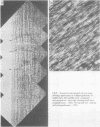Abstract
To maintain optimum mechanical properties in glutaraldehyde-treated heart-valve tissue the full collagen crimp geometry originally present in the relaxed fresh tissue should be retained. By varying the pressure at which glutaraldehyde fixation is carried out, considerable alterations to this crimp geometry can be achieved. The mechanical stiffness of the preserved tissue is consequently affected, and this in turn has a striking influence on both the opening behaviour of the valve and the degree of strain localisation in the leaflet tissue. A pressure of 100 mmHg eliminated the collagen crimp geometry entirely, and this resulted in the formation of sites of local strain or kinks in the valve leaflets during opening. It is expected that this strain localisation phenomenon will influence the long-term fatigue durability of the treated tissue. Pressures even as low as 4 mmHg result in significant reductions of crimp geometry. Fresh valves should therefore be fixed under a positive head of pressure sufficient only to ensure that the leaflets seal along their coapting free margins. A pressure of less than 1 mmHg was sufficient to achieve this. Leaflets of the commercially available Hancock valve show features similar to valves fixed in glutaraldehyde at about 100 mmHg pressure.
Full text
PDF










Images in this article
Selected References
These references are in PubMed. This may not be the complete list of references from this article.
- Albert H. M., Bryant L. R., Schechter F. G. Seven year experience with mounted porcine valves. Ann Surg. 1977 Jun;185(6):717–723. doi: 10.1097/00000658-197706000-00015. [DOI] [PMC free article] [PubMed] [Google Scholar]
- Broom N. D. Fatigue-induced damage in glutaraldehyde-preserved heart valve tissue. J Thorac Cardiovasc Surg. 1978 Aug;76(2):202–211. [PubMed] [Google Scholar]
- Broom N. D. Simultaneous morphological and stress-strain studies of the fibrous components in wet heart valve leaflet tissue. Connect Tissue Res. 1978;6(1):37–50. doi: 10.3109/03008207809152285. [DOI] [PubMed] [Google Scholar]
- Broom N. D. The observation of collagen and elastin structures in wet whole mounts of pulmonary and aortic leaflets. J Thorac Cardiovasc Surg. 1978 Jan;75(1):121–130. [PubMed] [Google Scholar]
- Broom N. D. The stress/strain and fatigue behaviour of glutaraldehyde preserved heart-valve tissue. J Biomech. 1977;10(11/12):707–724. doi: 10.1016/0021-9290(77)90086-0. [DOI] [PubMed] [Google Scholar]
- Brown J. W., Dunn J. M., Spooner E., Kirsh M. M. Late spontaneous disruption of a porcine xenograft mitral valve. Clinical, hemodynamic, echocardiographic, and pathological findings. J Thorac Cardiovasc Surg. 1978 Apr;75(4):606–611. [PubMed] [Google Scholar]
- Rose A. G., Forman R., Bowen R. M. Calcification of glutaraldehyde-fixed porcine xenograft. Thorax. 1978 Feb;33(1):111–114. doi: 10.1136/thx.33.1.111. [DOI] [PMC free article] [PubMed] [Google Scholar]
- Stinson E. B., Griepp R. B., Oyer P. E., Shumway N. E. Long-term experience with porcine aortic valve xenografts. J Thorac Cardiovasc Surg. 1977 Jan;73(1):54–63. [PubMed] [Google Scholar]
- Thomson F. J., Barratt-Boyes B. G. The glutaraldehyde-treated heterograft valve: some engineering observations. J Thorac Cardiovasc Surg. 1977 Aug;74(2):317–321. [PubMed] [Google Scholar]












